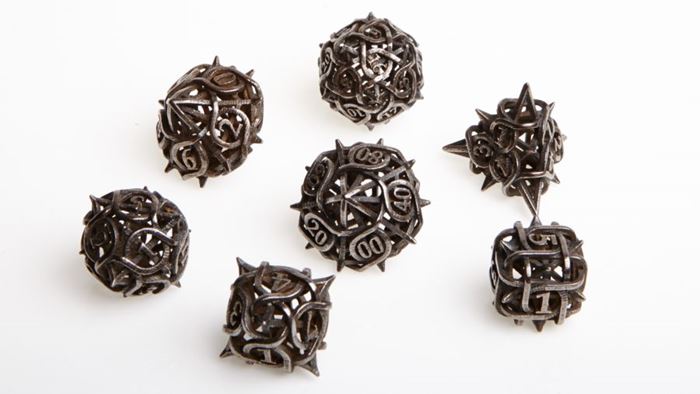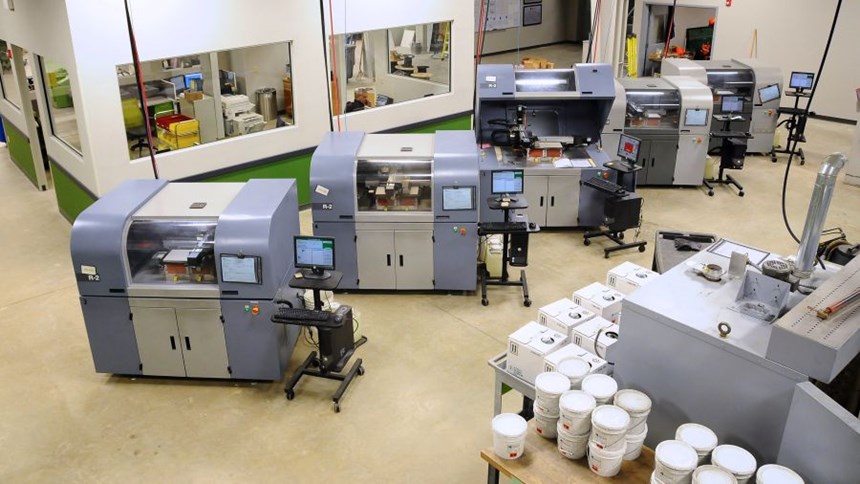ExOne Sees Growing Industrial Use of 3D Printing Marketplaces
Items produced from orders placed through consumer 3D printing services reveal growing use of these services by non-consumers.
Share
Read Next
The corporate headquarters for ExOne near Pittsburgh, Pennsylvania, is also the site of the company’s Production Service Center (PSC) for making metal parts. Rick Clark is the general manager of this facility, which 3D prints hundreds of parts per day on machines developed by ExOne. These additive machines use the company’s Binder Jetting process, which builds forms out of metal powder without melting the material.
Many of the parts made at the PSC are consumer items, says Clark. The reason for this is relationships the company has with 3D printing services that typically cater to consumers. Shapeways is an example—metal parts ordered though this 3D printing marketplace are often produced by ExOne. In fact, the volume of business from consumer-oriented resources such as this is so high that it accounts for 80 percent of the PSC’s part production in general, and nearly 100 percent of the activity near Christmas.
But Clark has also noticed something else—a gradual but significant change. It is no longer just consumer items he sees being ordered this way. In addition to metal jewelry and figurines, he now also sees orders, often batch orders, of what are clearly industrial components. Manufacturers are using these consumer sites as a means of uploading their component designs and obtaining metal parts.
When he first noticed this development perhaps three years ago, it was just an occasional curiosity. Not anymore, he says. He now estimates that industrial parts account for at least 15 percent of the parts ExOne sees from the online utilities.
Those parts are easy to spot, Clark says. Consumers order objects including home goods, custom pendants or hobbyist items such as ornate dice. But amidst these items in the batches of parts that ExOne runs can now also be seen brackets and machine components. One commonly recurring item is referred to by PSC staff members as the “sewing machine piece” because of its resemblance to a thread guide for a sewing machine. What this part actually does is unknown to them. Whatever function it serves, additive manufacturing seems to work as a means of producing the part, because the customer keeps ordering more.
John Baliotti is ExOne’s director of marketing and business development. He says the ability to make parts for customers by means of the PSC is an important part of almost any machine sale for the company. Binder Jetting is a distinctive process, an additive metal machine is a significant investment, and plenty of customers are still new to additive manufacturing. For all of those reasons, he says, prospective buyers generally convince themselves of the process’s effectiveness by commissioning various parts from ExOne before committing to a machine of their own.
Typically, this contract manufacturing takes the form of active engagement with the customer, including helping the customer refine the part design to take full advantage of Binder Jetting’s strengths. But now, he says, through any of various 3D printing services, it seems that manufacturers are also increasingly finding an even more basic way to begin. Consumer-focused 3D printing portals are providing industrial companies with a straightforward way to start to experiment and succeed with metal additive manufacturing.
Related Content
AM 101: NanoParticle Jetting (NPJ)
The proprietary process from XJet builds ceramic and metal parts using nanoparticle suspensions. Learn how NPJ works in this introductory article, part of our AM 101 series.
Read More10 Important Developments in Additive Manufacturing Seen at Formnext 2022 (Includes Video)
The leading trade show dedicated to the advance of industrial 3D printing returned to the scale and energy not seen since before the pandemic. More ceramics, fewer supports structures and finding opportunities in wavelengths — these are just some of the AM advances notable at the show this year.
Read MorePostprocessing Steps and Costs for Metal 3D Printing
When your metal part is done 3D printing, you just pull it out of the machine and start using it, right? Not exactly.
Read MoreAdditive Manufacturing Is Subtractive, Too: How CNC Machining Integrates With AM (Includes Video)
For Keselowski Advanced Manufacturing, succeeding with laser powder bed fusion as a production process means developing a machine shop that is responsive to, and moves at the pacing of, metal 3D printing.
Read MoreRead Next
3D Printing Brings Sustainability, Accessibility to Glass Manufacturing
Australian startup Maple Glass Printing has developed a process for extruding glass into artwork, lab implements and architectural elements. Along the way, the company has also found more efficient ways of recycling this material.
Read MoreAt General Atomics, Do Unmanned Aerial Systems Reveal the Future of Aircraft Manufacturing?
The maker of the Predator and SkyGuardian remote aircraft can implement additive manufacturing more rapidly and widely than the makers of other types of planes. The role of 3D printing in current and future UAS components hints at how far AM can go to save cost and time in aircraft production and design.
Read More4 Ways the Education and Training Challenge Is Different for Additive Manufacturing
The advance of additive manufacturing means we need more professionals educated in AM technology.
Read More











.png;maxWidth=300;quality=90)













